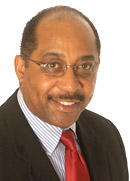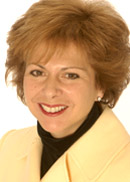THE RUN-UP TO DIGITAL TV
Multicast channels crowd bitstream
V-me, in Spanish, joins options for stations’ DTV broadcasts
The demand for programming to fill public TV stations’ new DTV multicast channels has suddenly produced an abundant supply of choices.
 New York’s WNET last week officially unveiled V-Me (pronounced veh-meh), a Spanish language service slated to launch next month in 16 markets. It is a PBS-style variety service for Latino viewers, announced in 2005 and developed quietly as WNET courted private investors to back the channel.
New York’s WNET last week officially unveiled V-Me (pronounced veh-meh), a Spanish language service slated to launch next month in 16 markets. It is a PBS-style variety service for Latino viewers, announced in 2005 and developed quietly as WNET courted private investors to back the channel.
Programming will include educational preschool children’s series such as Plaza Sesamo; how-to and lifestyle programs, including a telenovela; contemporary Spanish-language movies and performance shows; and factual and current affairs programs, including original productions of Viva Voz, a nightly talk show expected to have a broad range of guests and topics.
The telenovela, Nuestro Barrio, uses the typically steamy format to teach financial literacy, said Carmen DiRienzo, president of V-me. “It’s a telenovela that’s good for you,” she said.
V-me — and two other multicast channels offered earlier to stations, Create and World — were assembled by major producing stations while PBS’s attempts to start channels have been stymied by lack of capital. PBS’s proposed multicast channels PBS Kids Go! and Public Square were withdrawn or scaled back last year. PBS discontinued earlier program streams PBS Kids and PBS You.
World, a channel offering repeats of signature PBS documentary and news series, already airs in New York; Boston; Springfield, Mass.; and Washington, D.C. It aims for a national launch via PBS in July. WNET and Boston’s WGBH, which collaborated to create World in 2003, are licensing it through PBS.
Create, which went national in January 2006, is carried by 174 pubTV stations covering nearly 63 percent of the country, according to Cynthia Fenneman, president of American Public Television, which distributes the service in partnership with WGBH and WNET. The two stations developed Create, a mixture of how-to and lifestyle programs, in the same collaboration that conceived World. Create launched with the help of a one-time CPB grant of $500,000, Fenneman said.
Already “maxed out”
Although the upcoming launches give stations new options to upgrade their digital services, decisions to license them require evaluations of their own technical capacity to manage all the channels, as well as strategic thinking about how much capacity they should allocate among high-definition and standard-definition program streams. (Tech-watcher David Liroff offers an overview.)
Some broadcasters are assembling their own channels as well. Alabama’s APT network, for example, is gearing up to launch a locally programmed multicast stream on March 5. APT-IQ combines daytime children’s fare with family-oriented programs. But with new options arriving, Executive Director Allan Pizzato faces difficult choices about future channel lineups. As of March 5, APT’s digital lineup will include 24/7 broadcasts of PBS-HD and three standard-definition channels—the new APT-IQ, Create and a digital duplicate of its analog channel.
“We’re getting maxed out with our bandwidth—even though we have the latest encoders that make the best use of the bandwidth—and we can’t keep squeezing everything in there,” Pizzato said.
“Something has to go” so APT can air V-me or World, Pizzato told Current. He plans to make room for one of them by dropping PBS-HD at the end of the fiscal year and replacing it with an up-converted version of the standard-definition PBS feed, providing the National Program Service’s much broader content but without a true high-def picture. “That will allow me to not broadcast the SD-version of my analog signal and save a little bit of bandwidth,” Pizzato said. For true high-def programs, which are only a portion of the HD feed, APT would switch to HD, he said.
Pizzato’s plan may backfire, however, if its up-converted programming consumes even more capacity than real HD. That’s the experience at Milwaukee Public Television, according to David Felland, its engineering director. Felland told Current that genuine HD material can be compressed more efficiently for broadcast than noisier up-converted video.
Stations are having to make bit management decisions without enough information about how video source quality affects channel capacity, Felland says. “Nobody has a really good handle on this. The system needs to take a hard look at the technical advantages and business opportunities that cleaner video affords,” he says.
Deciding on a viable strategy for digital services may be as hard for PBS as for stations. At last month’s NETA Conference in Norfolk, Va., station execs asked PBS Chief Content Officer John Boland when, if ever, PBS’s NPS would complete its transition to all HD programming.
“I don’t think we can put an exact timeline on this,” Boland replied. “We are looking at February 2009 as the first benchmark, but we don’t know. You could also say we don’t know if it will happen at all,” Boland said, “but we think it will.”
V-me starts at 50-60 percent reach
Despite uncertainties about the end-stage of the digital transition, 18 stations made big commitments to carry V-me for its national launch March 5.
To carry V-me without paying a fee, the licensees agreed to carry the channel for 10 years. The contract allows stations to exit if V-me doesn’t maintain its promised standards for high-quality, educational programming, said DiRienzo, a WNET v.p. who developed the channel and plans to leave her station job this spring to go full-time with V-me.
Five of the V-me stations are in the 10 largest markets, and carriage is strongest in California and the Southwest. At launch, V-me will be available in markets representing more than 60 percent of Hispanic households and almost 50 percent of all television households.
V-me will feature many programs from WNET and other pubTV producers such as Sesame Workshop, BBC Worldwide and WGBH, which is co-producing a Spanish version of La Plaza featuring Maria Hinojosa. The telenovela is produced by a North Carolina nonprofit that advocates on behalf of the poor for fair financial services and lending practices.
The afternoon lineup includes Los Ninos en Su Casa, the daytime talk show from KCET in Los Angeles that helps parents and day-care workers prepare young children for school.
Many programs will be re-voiced or reversioned in Spanish. For example, host intros and interview segments that bookend WNET’s international doc series Wide Angle will be replaced with material featuring a Spanish-language host and expert guests who “discuss the subject in a culturally relevant way,” said DiRienzo.
“Our commitment is to maintain a standard of quality that is comparable to stations’ other services,” DiRienzo said. She is particularly proud of V-me’s six-hour children’s block, which will be unique among Spanish-language television networks.
V-me will market underwriting credits to companies looking to reach its Latino audiences with TV programs, Web content, educational programming and local events.
Private financiers are backing the venture through V-me Media Inc., a recently formed media production and distribution company. Baeza Group, an investment firm headed by Mario Baeza, a Wall Street lawyer and financier, and Syncom Funds, a venture capital firm specializing in media. WNET is a minority partner.
Baeza is a member of WNET’s Board of Trustees who in 2003 asked that his annual contribution to the station support research and development of a Spanish-language program service. When he later became interested as an investor, WNET took the channel proposal to other investment groups, and the deal was reviewed by various WNET Board committees and outside valuation experts, according to Josh Nathan, general counsel. Baeza recused himself from all discussions and decisions regarding the venture, Nathan said.
Where in the World is revenue?
Plans to launch World are still under wraps as PBS and its partners evaluate responses to a recent station survey fielded on PBS’s behalf by American Public Television. PBS is refining the channel’s budget and “looking at a range of support models,” said John Wilson, PBS senior v.p. of television programming, in an e-mail last week. Plans originally called for station fees to support the service.
World will repeat high-profile and signature PBS programs in a line-up that complements the PBS schedule and avoids program duplication, which is discouraged by public TV’s digital carriage deal with the National Cable Television Association.
“We know how important nonfiction documentaries and news analysis are to the public television brand,” said Jon Abbott, exec v.p. of WGBH. “World was conceived to make the most of that value and distinctiveness.”
Making PBS programs available at alternative times expands options for viewers and allows PBS to give additional plays to worthy programs from the pubTV library, Abbott said.
Web page posted March 20, 2007
Copyright 2007 by Current Publishing Committee

